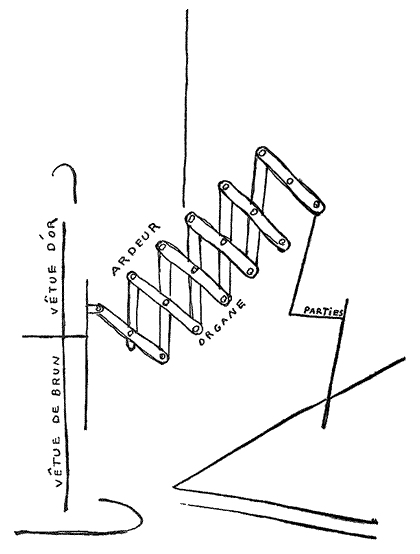Picabia’s book of writings and drawings, I Am a Beautiful Monster, is wrapped in a brown-bag cover of monsterdom, while George Baker’s book about Picabia, The Artwork Caught by the Tail, is presented in a costume of gleaming gold: so we have the modest-appearing original, with its provocative title, and the shiny interpretation of that writing and drawing. In Marc Lowenthal’s masterful translations and commentary, the footnotes are wildly informative and the plays of typography delightfully rampant. Examples of the aphorisms: ‘The brothel is the place where one feels most at home’ or ‘Life has only one form: forgetting’ or ‘To those talking behind my back: my ass is looking at you.’ The drawings seem an essential part of the publication, although it turns out that Picabia himself published his drawings and his poems separately. Too bad: as Lowenthal points out, they lead to the concrete poetry soon to be seen on the horizon.
The evolution of Picabia’s style and interests are carefully documented, from the early chapters ‘I Am Looking for a Sun: Pre-Dada, 1917-19’ and ‘You Bunch of Idiots: Dada, 1919-1921’ to ‘I’ve Never Believed in Myself: Late Writings, 1950-53’ and finally ‘My Pencil Buckles: Posthumous Writings’. This is well-translated, controlled and footnoted territory. Picabia is hard to keep up with, behind the steering-wheels of his cars (as he is seen, smiling ear to ear, in the most famous portrait-photo) in Zurich, New York or Paris. Lowenthal manages it and explains, in notes or brief introductions to the texts, why Picabia’s branch of Dada, beginning with Barcelona Dada, did not merge with other Dadas, why his later aphorisms and texts come from Nietzsche, and how his writings evolve, up to the late ones, which manifest the ‘recycling of detritus’, or unacknowledged material: appropriation, that is, as opposed to literary collage (which is based on texts whose authorship is acknowledged).
‘Funny Guy’, as Picabia called himself, did some funny things. He proposed a chess match between Henri-Pierre Roché and himself, the stakes being whose journal, Picabia’s 391 or Roché’s Rongwrong would continue: Picabia won, so 391 went on, while the 34 moves of that fateful game were printed in the single issue of Rongwrong, published in New York. The mecanomorphs or machine drawings are funny enough: take the one labelled ‘Witticism Machines’ (the words attached read: ‘Machine de Bons Mots’, ‘Oreille Fatigante … des Paroles’, ‘Opéra’ and ‘Les Bavards’), so it’s all about talking too much, if wittily, and exhausted hearing. Others are salutes: to the ‘Egoist’ with reference to narcissism, to paradoxical concoctions like the ‘Mortician’s Athlete’ and to other avant-garde figures: ‘Hello Ribemont-Dessaignes!’
Such texts give the translator both headaches and field days; Poésie ron-ron, for example, becomes here
Purring
Poetry
while in another version, by Judd and Renée Riese Hubert, it becomes ‘Purr Verse’. Picabia enjoyed such things: his first Dada book published in Paris, which preceded the first event of Paris Dada, engineered by Tristan Tzara, was called Thoughts without Language and prefaced by ‘Udnie’, variously identified as Duchamp’s ‘Bride’, as his own response, as Jean d’Udine and so on. Duchamp was Picabia’s colleague in the Dada spirit at the end of 1912, Picabia pointed out, before a parting of the ways with ‘certain Dadas’ among whom he felt stifled. ‘The bourgeois represent the infinite; Dada would be the same if it lasted too long.’ But it didn’t last too long.
The perfect companion to Picabia’s writings is Baker’s amusing, sometimes difficult, but essential study. So long and so happily have many of us thought of and translated Tzara’s version of Dada that we have lost sight of the others, among them Picabia’s – here seen in the poems and mecanomorphs. These are drawings really, machine-type lines with a few labels, names or nicknames or in-jokes, all contextualised by Baker, and explained when need be.
Words are repeatedly analysed for their various meanings, sometimes overanalysed, although Baker is writing about a movement that is thought to have sought meaninglessness. Much of Picabia’s wordplay is based on multiple meanings, on sounds and connotations we might miss. All this detail is necessary, Baker says, referring to his pages on the dates and import of specific works whose crucial nature has been elided: ‘I apologise for the minute details, for the mundane quality of the evidence, but this story must be told.’ Told it is, and only sometimes overtold. Very occasionally, I found myself wishing Baker had overlooked or failed to hear the ramifications of certain words and sounds, when they don’t seem quite to stand up to the weight of interpretation. Picabia loves to shout and point at and point out (‘cries, heralds, proclamations’, Baker says, exemplifying this with Picabia’s titles for his mechanical drawings: ‘Ici, c’est ici Stieglitz’, ‘De Zayas! De Zayas!’, ‘Voilà Haviland’ and ‘Voilà Elle’).
What discoveries! For years, I have thought (and I am willing to bet something or other that many thought along with me) that the front cover of the last issue of 391 (19 October 1924), also called the Journal de l’Instantanéisme, with its motto directly under the title in small caps, ‘L’INSTANTANEISTE EST UN ETRE EXCEPTIONNEL CYNIQUE ET INDECENT’, carried the profile of Marcel Duchamp. Looks like him, sounds like him, must be him, right? Nope. It is Georges Charpentier, the famous boxer whom Picabia had sketched the year before. What does this change? Lots. Like the photograph of Stéphane Mallarmé that shines through (OK, merely shows through, if you are less bedazzled by the Master than I am) André Breton’s essay on ‘Le Merveilleux contre le mystère’, this image has seemed to me to be spontaneity itself, with all its eternal motion in Duchamp time.
L’INSTANTANEISME: doesn’t want yesterday.
L’INSTANTANEISME: doesn’t want tomorrow.
L’INSTANTANEISME: believes only in perpetual motion.
And on top of that, it turns out that since instantané also means ‘snapshot’, this passion for photography means that Instantanism is also Snapshotism. Like Picabia’s ‘ballet instantanéiste’, a snapshot of a dance. Why not? That ballet, Picabia’s Relâche, played precisely against its title of non-performance (‘relâche’ – that is, the theatre is dark), was revolutionary. Instead of stage lights sitting static between audience and performers, flashes like strobe lights timed to the music lit up the audience, ruling against the performance itself, which was already split in two, the dance broken up by the film Entr’acte, an act of betweenness if there ever was. Between the two halves of a non-performance performed against the spectators, as well as against their expectations.
A process about performance, a performance as anti-process: Baker makes a big point about Cubism being about structure – Picabia experimented with Cubism early in his painting career – and Dada being about process. But more about photos. Of Baker’s five chapters – ‘Dada Drawing’, ‘Dada Painting’, ‘Dada Photography’, ‘Dada Abstraction’ and ‘Dada Cinema’ (followed by a Dada montage called ‘Long Live Daddy’, enough said) – the third one has a particular fascination for the author, and for me too. The Dadaphoto opens up, Baker says, ‘entirely new forms of exchange, new modalities of visual equivalency, an entirely other symbolic economy’. I won’t try to paraphrase his discussion of the way Man Ray’s photograph of Elsa von Freytag-Loringhoven’s naked body is collaged with a coat rack to form the letter A of ‘Amérique’, thereby suggesting an important ‘form of fusion’, and why that is so important – don’t we remember that particular letter somewhere in American literature? ‘KEEP SMILING,’ reads the label attached to this Dadaphoto in the journal New York Dada. ‘We sense here,’ Baker continues, ‘that the chain of signifiers of Dada symbolisation itself is opened onto love and thus to joy.’
Baker’s book begins with the simple word and title: ‘Zone’. A good way to set off, since it refers to Apollinaire’s poem of the same name, and announces, here, a voyage by Picabia and Apollinaire in one of Picabia’s cars, from Paris to Boulogne, and then by boat to England. This works well because of the famous photograph of Picabia behind the steering-wheel, and because the poem is right up there with Cendrars’s ‘Prose du Transsibérien et la petite Jeanne de France’ as one of the favourite verbal icons of French Modernism.
Some really great stuff here: the ‘visual deracination’ of the mechanomorph, with the page serving as cultural, not natural ground; Picabia’s ‘Transparencies’ of the late 1920s, leading back to the literally transparent works of 1920; his overpainting, pigmenting of his readymade sources ‘in a game of opacification and effacement’. Opacification: how not to love it? In the chapter on ‘Dada Painting’, the central artwork or painting ‘caught by the tail’ – the title refers to Picasso’s wartime play Desire Caught by the Tail – is L’Oeil cacodylate: the eye dilated by caca or excrement. A collective manifesto signed or ‘signed’ by many names, obscure and celebrated, real or faked. Picabia loves pastiche.
Having read about Duchamp, we might expect something about the readymade. And Baker reminds us that Rosalind Krauss sees Man Ray’s objects, such as the eggbeater labelled Man (a partial self-portrait as well as a joke), as resisting the logic of exchange of which so much has been and so readily made. My favourite manifestation of this refusal is Picabia’s signature as a drawing, shown in these pages, which Baker calls
an extraordinary gesture, deeply complex and immensely ludicrous at the same time … as if Picabia were saying that the entire logic of the readymade could be reduced to the authorising gesture of the signature … that elevates the chosen object into the domain of art … signs the authorising gesture itself; he signs, that is to say, a sign(ature), placing the logic of the readymade en abyme.
So it’s about reflexivity, a signature become the work of art.
Send Letters To:
The Editor
London Review of Books,
28 Little Russell Street
London, WC1A 2HN
letters@lrb.co.uk
Please include name, address, and a telephone number.


